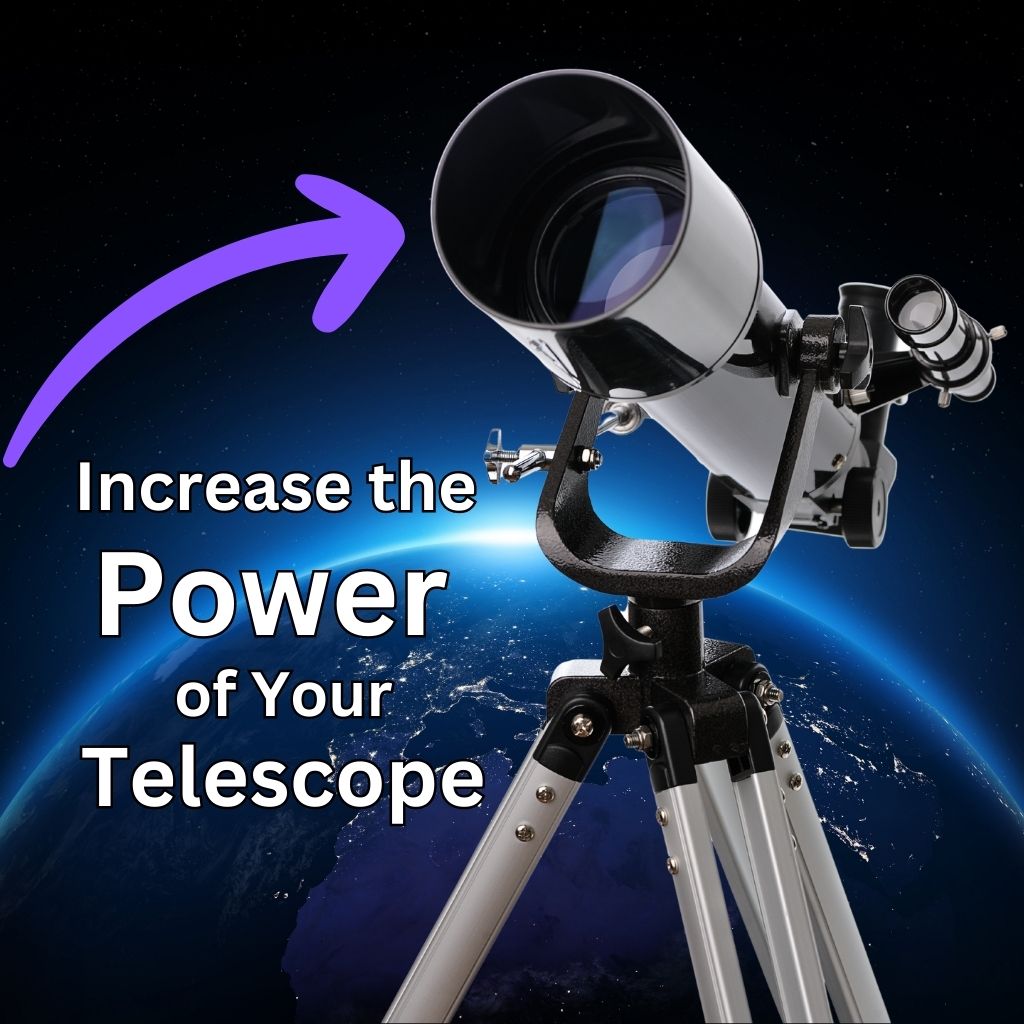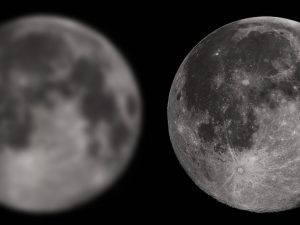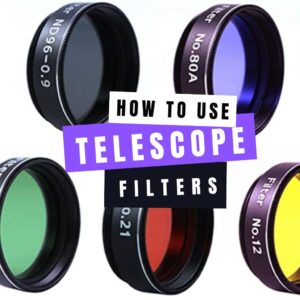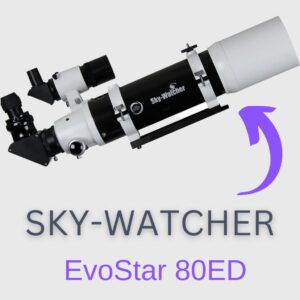This site contains affiliate links to products. I may receive a commission for purchases made through these links.
The best way to increase your telescope’s power is by increasing the magnification using a Barlow lens and an eyepiece with a shorter focal length. The magnification is more significant when the focal length of the objective increases or when the eyepiece’s focal length decreases.
It’s essential to understand how the power of a telescope is impacted by its magnification and focal length while shopping for one.
This article will cover the roles magnification and focal length play, how they complement one another, and what you can do to get the most out of them to help you elevate your stargazing experience.
How to calculate the magnification power of your telescope?
There are a bunch of factors you need to equate to calculate your telescope’s power. To calculate the power of your telescope, you must know the scope aperture, scope focal ratio, eyepiece focal length, apparent field, etc.
The magnification, or power, is the ratio of the telescope’s focal length (the objective lens or primary mirror) to the eyepiece’s focal length.
The resulting ratio gives the magnification power of your telescope that helps enlarge the object you’re trying to view.
The formula for calculating the magnification is as follows:
Let’s try to understand this better with an example.
If you have a telescope that has an eyepiece with a focal length of 6 mm combined with a focal length of 1,200 mm, the resulting magnification will be:
1,200/6 = 300 times magnification.
When you consider magnification in theory, it’s unlimited. But the limits imposed are related to the aperture of the optics, which cannot be unlimited.
You can increase the telescope’s magnification using some eyepieces. Some great options include the Celestron zoom eyepiece, the Celestron 2” eyepiece, the filter accessory set, and the Celestron Omni series eyepiece.
What is a good magnification for a telescope?
As a rule of thumb, a telescope’s optimal useful magnification is twice its aperture in millimeters and 50 times its aperture in inches. Going any higher makes the image blurry and not useful.
That means a 6-inch aperture will give 300x before the images turn fuzzy, an 8-inch aperture will give 400x, and so on.
However, this rule only sometimes holds. Other factors like the atmospheric conditions, the time of the day, the angle, and more can affect the magnification.
Atmospheric conditions have a massive impact on higher magnification.
Let’s say you pull out your telescope to observe Saturn with a high magnification on a night with poor atmospheric conditions. You’ll experience a blurred and distorted image and won’t be able to see anything clearly, even if you lower the magnification.
Thus, the example explains how magnification isn’t the only factor in the equation when devising a good magnification for your telescope for viewing a detailed image of a deep-space object.
All in all, the ideal magnification of a telescope depends on so many external factors. You have to account for the aperture size, the celestial body you want to observe, the atmospheric conditions, and more.
Let’s discuss three important magnifications you should be aware of when altering the magnification of your telescope.
Minimum magnification
The telescope’s aperture is responsible for setting the lower limit for magnification. The exit pupil (the beam of light exiting the eyepiece and entering your eye) size shouldn’t exceed 7mm, the largest diameter your eye pupil can attain.
However, minimum magnification can only be done in absolute darkness at night. To calculate the minimum magnification, divide the telescope’s aperture by the maximum aperture diameter of the eye’s pupil.
Optimum magnification
When a star appears as a small disk surrounded by diffraction rings instead of a point-shaped object, it indicates the optimal or maximum useful magnification.
This signifies that the available resolving power of the optics is fully utilized, enabling you to perceive hidden details that may be invisible at lower or higher magnifications.
An eyepiece exit pupil of 0.7 mm to 0.8 mm should be used to achieve this maximum helpful magnification. This isn’t a rigidly defined limit, but it helps to give you a good reference point for attaining the optimal magnification for your telescope.
Maximum magnification
The maximum magnification is different for every telescope. However, in most cases, the maximum magnification is equal to twice the size of the telescope’s lens aperture.
Using the maximum magnification every day isn’t a smart move. But there’s a way you can determine whether or not to operate at this limit.
You can observe the object by using an eyepiece with a 0.5 mm exit pupil. Using the maximum magnification won’t be practical if the object seems blurry or too dark.
You may also like: What Magnification Do You Need to See Planets?
How to calculate the focal length of your telescope?
Multiply the focal ratio by the diameter of its primary optic to evaluate your telescope’s focal length. As for the focal ratio, you can get it by dividing the focal length by the diameter of its objective.
Thus, without no knowledge of how a focal length works, you cannot expect to utilize it optimally.
Imagine you’re venturing out into the vast unknown with your telescope and exploring distant galaxies and planets. How does a telescope do that?
It’s all because of the focal length that bridges the lens or mirror and the image that forms. The longer this bridge will be, the closer you’ll be to your target. It’s also responsible for determining the focal ratio (f/number).
The focal ratio acts like a speedometer for your telescope that helps you measure how fast you can capture images when venturing through the cosmos.
What is the best focal length for a telescope?
You should typically look for a focal length of at least 600mm. The range depends on the object you want to view. If the object in question is a planet, opting for a focal length between 1500mm to 2000mm will be ideal.
The distance between the exit and entry points of your telescope is the focal length which also passes through the focal point in your telescope.
The exit point is where the eyepiece goes (the focuser) so you can view the image being formed. The entry point is the front lens. Thus, the main job of the focal length is to determine the field of view and the magnification.
If you’re intimidated by stars, nebulae, or galaxies at large, you’d want to work with a focal length that’s typically lower than the one used for spotting planets.
No matter what your focal length is, you’ll be able to see all objects. The only difference will be in the details, so you should optimize your telescope’s focal length.
How to increase the focal length of a telescope?
Accessories like a Barlow lens or a focal extender are great add-ons you can use. They effectively increase the focal length when placed in the focuser, increasing the distance between the front lens and your eye.
But if you’re looking to bring an opposite effect, like decreasing your telescope’s focal length, you can always employ a focal reducer.
These reducers are essentially small lenses or mirrors that carry a positive power. This combination lowers the focal length.
For instance, a telescope with a focal length of 800mm can use a 0.5x focal reducer to reduce the focal length to 400mm.
How does the focal length affect the magnification of your telescope?
The focal length of a telescope determines the angle of the image projected from the objective lens or mirror to the eyepiece. A higher focal length would result in a narrower angle with a greater depth of focus, allowing the image to penetrate further into the eyepiece without losing focus.
On the other hand, a lower focal length produces a broader angle and shallower depth of focus, providing less flexibility with the focuser.
Although both focal lengths can produce the same magnification, the shorter focal length reaches the limits of its focus sooner than the longer focal length, causing the object to expand as it goes out of focus.
The focal length and magnification have a strong correlation that much is clear till now. However, it’s essential to understand how the focal length affects the magnification so you can take the maximum benefit from your telescope.
In simple words, magnification means to bring the object you want to view close, while the focal length alters the field of view.
How to increase the magnification of your telescope?
If you want to gaze at the moon’s craters or the details in Saturn’s detail, then it’s essential to crank up the magnification on your telescope.
We’ll look at how you can achieve optimal magnifying power by making a few changes to your telescope.
Increasing telescope magnification with a Barlow Lens
Inserting a Barlow lens into your telescope is by far the most effective way to increase the magnification of your telescope. You can do this by placing the Barlow lens in front of the eyepiece.
The Barlow lens is diverging, which causes light to spread out. Combined with a telescope, it increases the focal length, magnifying the object. Barlow lenses have different classifications that increase the original magnification power.
You may also like: The Best Barlow Lens for Any Telescope (Buying Guide).
Increasing telescope magnification with the eyepiece
Experimenting with different eyepieces is one way to increase your telescope’s magnification. The magnification depends on the focal length of the eyepiece as the magnification is the ratio between the focal length of the eyepiece and the telescope.
Let’s understand this better with an example.
If you have a telescope with a focal length of 1000mm and an eyepiece with a focal length of 20mm, the magnification ratio would be 1000/20 = 50x. However, changing the eyepiece would change the focal length too.
You can also buy a special zoom eyepiece. It is a single eyepiece where you can adjust the focal length by turning the barrel like the camera lenses.
The advantage of the zoom eyepiece is that you have only one eyepiece and don’t have to change it in the focuser when you need to use another magnification. It is also a cheaper option than owning a bunch of different eyepieces.
The standard focal length range with the zoom eyepieces is 7mm to 21mm and 8mm to 24mm. The Baader Planetarium 8-24 mm Mark IV Hyperion Universal Zoom is recommended.
Increasing telescope magnification with an extension tube
Another way is to add the extension tube between the Barlow lens and the eyepiece. You can create an extension tube using a 1-inch PVC tube and sand it lightly to fit properly onto the Barlow barrel and increase the magnification power.
You can easily double, triple, or even further increase the magnification depending on the size of the extension tube and the number of Barlow lenses you use.
Takeaway: Enhance your stargazing experience by learning how to increase the power of your telescope
Harnessing the power of your telescope truly helps you push it to its potential. So whether you’re a newbie or trying to crank up a notch to make your experience more enjoyable, it’s essential to understand how to use these features to your benefit.
Understanding how these lenses and different eyepieces can help increase magnification and also raise the power of your telescope is very helpful.
Don’t forget to subscribe to our newsletter where you’ll find the latest cosmic discoveries, expert stargazing tips, and exclusive subscriber deals. Embark on your cosmic journey if you haven’t already!
Read also:







